
PUMPA - SMART LEARNING
எங்கள் ஆசிரியர்களுடன் 1-ஆன்-1 ஆலோசனை நேரத்தைப் பெறுங்கள். டாப்பர் ஆவதற்கு நாங்கள் பயிற்சி அளிப்போம்
Book Free Demo- The term angiosperms is a combination of two Greek words 'angio' which means covered and 'sperma', which means seed.
- They are commonly known as flowering plants. The flowers produced by the plants develop to form fruits inside which seeds are produced.
Their life cycle is similar to that of the gymnosperms. The reproductive organs of these plants are found inside the structure known as the flower. Inside the flowers, the ovule is enclosed within a carpel (female reproductive organ) that develops into the fruit. The sporophyte is the dominant phase of these plants.
These plants maybe
- Herbs
- Shrubs
- Trees
Example:
Herbs
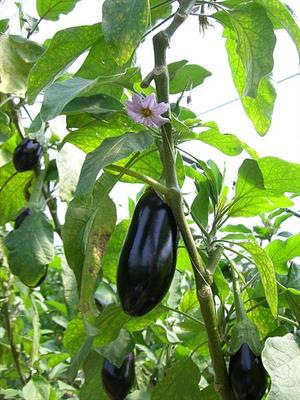
Solanum melongena(brinjal)
Shrubs
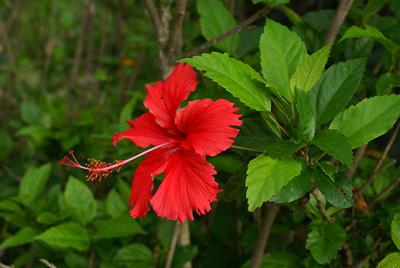
Hibiscus rosasinensis (Hibiscus)
Tree
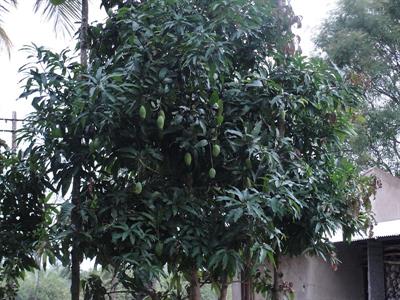
Mangifera indica(Mango)
These are the plants that have well developed vascular tissues, as their
- Xylem contains vessel, tracheid, xylem parenchyma and xylem fibre
- Phloem contains sieve tubes, phloem parenchyma, companion cells and phloem fibres.
Classification of angiosperms:
The embryos inside the seeds of the angiosperms have structures known as cotyledons or seed leaves. At most times, these structures emerge green in colour during seed germination. Based on the number of cotyledons found in the seeds, the angiosperms are divided into two classes such as:
- Dicotyledons
- Monocotyledons.
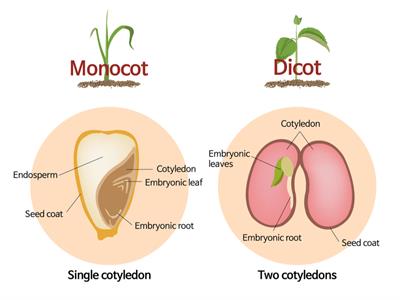
Characteristics of dicotyledons:
The plants which produce seeds with two cotyledons are known as dicots.
- The seeds of these plants have two cotyledons.
- These plants have a tap root system, and broad leaves with a network of veins (reticulate venation).
- They have tetramerous or pentamerous flowers whose calyx and corolla are well differentiated.
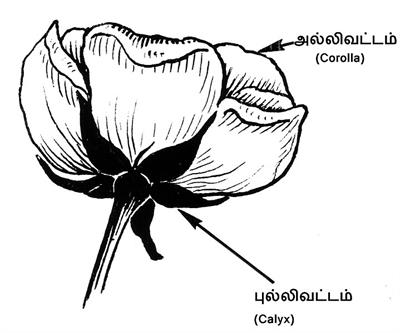
Calyx and corolla of a flower
- In these plants, pollination occurs by insects.
Example:
Bean, mango, neem, rose, sunflower, peas, almonds, pumpkin and lily.
Characteristics of monocotyledons:
The plants whose seeds have a single cotyledon are known as monocots or monocotyledonous.
- The seeds of these plants have only one cotyledon.
- These plants have fibrous root system, long leaves with parallel venation.
- They have trimerous flowers which are not differentiated into calyx and corolla.
- In these plants, pollination occurs by the wind.
Example:
Grass, paddy, banana, wheat, rice, maize and bamboo are examples of monocots.
Economic importance of angiosperms:
1. As primary producers:
In most terrestrial ecosystems, these plants serve as the primary source of food as they perform photosynthesis. Hence, they are known as the primary producers.
2. As sources of food:
Majority of the food that we eat comes from angiosperms. All the cereals, pulses, spices, most of the vegetables and fruits are angiosperms.
3. As sources of drugs:
Most of the angiosperms contain chemical compounds which have significant medicinal properties in them.
Reference:
https://commons.wikimedia.org/wiki/File:Solanum_melongena_ja001.jpg
https://commons.wikimedia.org/wiki/File:Hibiscus_rosa-sinensis_flower_2.JPG
https://commons.wikimedia.org/wiki/File:Mango_tree_-_Dadaga.jpg
https://commons.wikimedia.org/wiki/File:%E0%AE%85%E0%AE%B2%E0%AF%8D%E0%AE%B2%E0%AE%BF%E0%AE%B5%E0%AE%9F%E0%AF%8D%E0%AE%9F%E0%AE%AE%E0%AF%8D-%E0%AE%AA%E0%AF%81%E0%AE%B2%E0%AF%8D%E0%AE%B2%E0%AE%BF%E0%AE%B5%E0%AE%9F%E0%AF%8D%E0%AE%9F%E0%AE%AE%E0%AF%8D.jpg
https://commons.wikimedia.org/wiki/File:Hibiscus_rosa-sinensis_flower_2.JPG
https://commons.wikimedia.org/wiki/File:Mango_tree_-_Dadaga.jpg
https://commons.wikimedia.org/wiki/File:%E0%AE%85%E0%AE%B2%E0%AF%8D%E0%AE%B2%E0%AE%BF%E0%AE%B5%E0%AE%9F%E0%AF%8D%E0%AE%9F%E0%AE%AE%E0%AF%8D-%E0%AE%AA%E0%AF%81%E0%AE%B2%E0%AF%8D%E0%AE%B2%E0%AE%BF%E0%AE%B5%E0%AE%9F%E0%AF%8D%E0%AE%9F%E0%AE%AE%E0%AF%8D.jpg